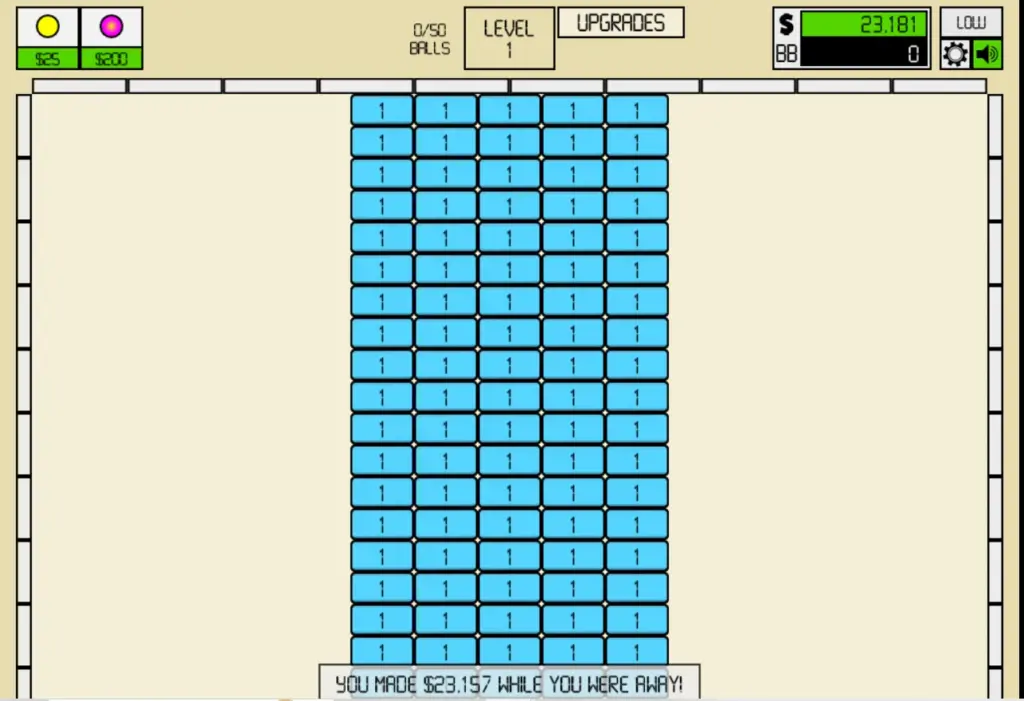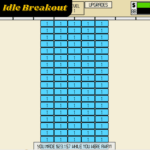Idle Breakout: The Ultimate Math Game for Strategic Brain Development
Discover how Idle Breakout combines mathematical thinking with satisfying gameplay mechanics, creating a brain-training experience as elegantly designed as a something conical in a chemistry lab—structured for precision and results.
What Makes Idle Breakout a Math Game?
Idle Breakout represents a sophisticated evolution of the classic arcade game, transforming simple brick-breaking mechanics into a comprehensive mathematical and strategic experience. Developed as an idle clicker game, Idle Breakout challenges players with exponential growth calculations, resource optimization, and strategic upgrade sequencing—core elements of mathematical thinking and computational reasoning.

At its heart, Idle Breakout requires players to master fundamental mathematical concepts: calculating return on investment (ROI) for upgrades, understanding exponential growth curves, managing finite resources across multiple competing priorities, and predicting long-term progression through numerical modeling. These aren't mere gameplay mechanics—they're exercises in applied mathematics that develop genuine numerical literacy and analytical skills.
The game's elegant simplicity belies profound mathematical depth. Like a well-designed something conical in a chemistry lab that efficiently funnels liquids through precise geometric proportions, Idle Breakout channels player effort through mathematical systems that reward strategic thinking and numerical optimization. Every upgrade decision involves implicit calculus, every progression curve reflects exponential mathematics, and every achievement represents conquest over numerical complexity.
Whether you're a mathematics enthusiast seeking engaging practice, an educator exploring game-based learning, or a casual player enjoying satisfying progression mechanics, Idle Breakout offers surprising mathematical depth beneath its accessible surface.
Idle Breakout Gameplay Mechanics and Mathematical Foundations
The Basic Progression Loop
Idle Breakout operates on an elegant core loop: click bricks to destroy them, earn currency, purchase upgrades, automate destruction, and progress through increasingly difficult levels. While seemingly simple, this loop embeds profound mathematical principles:
- Manual Phase: Players initially break bricks by clicking, earning small amounts of currency per action. This linear phase establishes baseline progression rates.
- Automation Phase: As players purchase balls, gameplay transitions from linear (manual clicking) to exponential (automated attacks). This transition is mathematically significant, marking the shift from additive to multiplicative growth.
- Optimization Phase: Advanced players balance multiple ball types, power-ups, and upgrade sequences to maximize efficiency—a genuine optimization problem requiring mathematical analysis.
Currency and Economic Systems
Idle Breakout implements a sophisticated economic system where currency acquisition follows mathematically predictable patterns. Players earn base currency through brick destruction, with each brick's value determined by its numerical designation. The economic model incorporates:
- Linear initial earnings from manual clicks
- Exponential growth through automated ball systems
- Logarithmic diminishing returns as difficulty increases
- Multiplicative bonuses from special power-ups and rare events
Players naturally develop intuitive economic reasoning, understanding concepts like cash flow, return on investment, and opportunity cost—mathematical ideas fundamental to finance, business, and engineering.
Ball Types and Strategic Mathematical Optimization
Idle Breakout features six distinct ball types, each with unique damage patterns, costs, and effectiveness levels. Selecting the optimal ball combination requires mathematical analysis comparable to portfolio optimization in investment theory.
Ball Type Comparison and Cost-Benefit Analysis
- Basic Ball: Entry-level option with moderate cost and damage. Serves as a mathematical baseline for comparing other balls' efficiency.
- Plasma Ball: Increased cost but area-effect damage, hitting multiple bricks simultaneously. ROI calculation requires dividing damage output by cost and accounting for area coverage.
- Sniper Ball: Specialized targeting mechanism prioritizes isolated bricks. Mathematical value depends on brick distribution patterns—more valuable when bricks are scattered, less valuable in dense formations.
- Scatter Ball: One ball spawns multiple projectiles. Geometric multiplication of effective damage: 1 ball becomes 3-5 balls, representing multiplicative power scaling.
- Cannonball: Maximum single-target damage with highest cost. Appeals to players favoring concentrated firepower over area coverage—a strategic choice with mathematical trade-offs.
- Poison Ball: Damage-over-time mechanic adding temporal dimension to strategy. Requires calculating present value of delayed damage versus immediate alternatives.
Optimal ball selection depends on mathematical modeling of level geometry, enemy distribution, damage calculations, and economic constraints. Players engage in sophisticated algorithmic thinking without formal training in mathematics.
Mathematical Concepts Embedded in Idle Breakout
Exponential Growth and Progression Curves
Idle Breakout's progression exemplifies exponential growth mathematics. Early game advancement feels slow (linear phase), then suddenly accelerates as players unlock automation (exponential phase). This mirrors real exponential functions where growth initially appears minimal before rapidly accelerating.
Players intuitively learn exponential thinking—understanding that small multipliers compound into massive advantages over time. This mathematical intuition transfers directly to understanding investment returns, viral growth, bacterial reproduction, and countless real-world phenomena governed by exponential mathematics.
Resource Allocation and Linear Programming
Strategic upgrading in Idle Breakout is mathematically equivalent to linear programming problems—allocating finite resources across competing objectives to maximize outcomes. Players must decide: invest in speed for faster progression, power for greater damage, or quantity for redundancy? This requires weighing competing priorities and calculating trade-offs.
The mathematical concepts parallel operations research, supply chain optimization, and engineering resource allocation. Players develop practical understanding of these sophisticated mathematical disciplines through engaging gameplay.
Probability and Expected Value
Power-ups and special events introduce probabilistic elements requiring expected value calculations. Players unconsciously evaluate: "If power-up succeeds (80% chance), providing 10x multiplier, versus guaranteed 2x multiplier, which is worth buying?" This is expected value calculation, fundamental mathematical reasoning used in decision science and economics.
Some versions of Idle Breakout include rare ball drops and bonus events, adding stochastic elements that reward understanding probability and expected value. Strategic players naturally develop intuition for these mathematical concepts through repeated exposure and reinforcement.
Logarithmic Diminishing Returns
As players progress through levels, advancement becomes increasingly difficult. This models logarithmic functions where progress per unit effort decreases as total output increases. Understanding this mathematically prepares players for recognizing similar patterns in real-world systems where costs escalate nonlinearly with scale.
Idle Breakout vs. Other Math Games
| Game | Primary Math Skill | Cognitive Demand | Long-Term Engagement |
|---|---|---|---|
| Idle Breakout | Resource optimization, exponential growth, ROI analysis | Medium-High | Very High (infinite progression) |
| 2048 | Number combinations, spatial reasoning | Medium | Medium (limited challenge) |
| Sudoku | Logic deduction, constraint satisfaction | Medium-High | High (varies by difficulty) |
| Math Bingo | Basic arithmetic (addition, subtraction, multiplication) | Low-Medium | Low (repetitive mechanics) |
| DragonBox | Algebra, equation solving | Medium | Medium-High (progressive complexity) |
| Threes | Number patterns, strategic planning | Medium | Medium (achievable mastery) |
Idle Breakout occupies a unique niche, combining continuous progression with sophisticated mathematical concepts. Unlike games with finite endpoints, Idle Breakout's infinite progression ensures sustained mathematical engagement, making it valuable for developing sustained numerical thinking—essential for advanced mathematics, engineering, and scientific inquiry.
Scientific Evidence: Math Games and Cognitive Development
Math Game Effectiveness Research
Recent neuroscience research establishes convincing evidence supporting the cognitive benefits of mathematically-oriented games. A study published in Educational Research Review examined game-based mathematics interventions across 112 studies, finding significant positive effects on student mathematical achievement. The meta-analysis revealed that games targeting specific mathematical skills produced medium to large effect sizes.
Working Memory and Numerical Reasoning
Research from the National Center for Research on Evaluation, Standards, and Student Testing (CRESST) found that games requiring resource optimization—like Idle Breakout—significantly enhance working memory capacity. Players simultaneously track multiple numerical variables (current currency, upgrade costs, power levels, progression metrics), exercising working memory systems critical for mathematical reasoning, programming, and complex problem-solving.
Transfer Effects to Academic Mathematics
A peer-reviewed study in PLOS ONE found that video game play time predicted mathematical performance through improvements in fluid intelligence and planning abilities. Critically, benefits transferred to formal mathematics assessments not practiced during gameplay—suggesting genuine mathematical skill development rather than simple task-specific improvement.
Strategic Thinking and Decision-Making
Games requiring economic optimization, like Idle Breakout, activate neural systems supporting strategic thinking, long-term planning, and decision-making under uncertainty. fMRI studies show that such games activate the prefrontal cortex regions critical for executive function, mathematical reasoning, and complex cognition.
Advanced Mathematical Strategies for Idle Breakout Mastery
Optimal Upgrade Sequencing Algorithm
Expert players develop upgrade sequences maximizing long-term efficiency. This requires calculating breakeven points: determining when upgrading each ball type maximizes return on currency invested. The mathematical analysis resembles marginal analysis in economics, comparing marginal benefit (additional damage from upgrade) to marginal cost (currency spent).
Compound Interest Thinking
Advanced strategies recognize that early upgrades compound through the entire game. A 10% efficiency gain purchased early affects all subsequent gameplay, multiplying in impact through exponential growth mechanisms. This models compound interest mathematics: small early advantages become substantial advantages through multiplication over time.
Power-Up Expected Value Optimization
Strategic players calculate expected value of purchasing power-ups: does a 50% probability of 3x multiplier justify the cost, compared to guaranteed 1.5x alternatives? This expected value calculation is sophisticated mathematical reasoning applicable to decision science, finance, and game theory.
Level Difficulty Prediction and Preparation
Experienced players develop mathematical models predicting when levels become unbeatable with current equipment. By analyzing damage output curves against level health progression, players forecast when new upgrades become necessary. This predictive mathematical modeling mirrors forecasting in business, meteorology, and scientific research.
Educational Applications of Idle Breakout
Classroom Mathematics Instruction
Progressive educators incorporate Idle Breakout into mathematics curricula to teach exponential functions, economic systems, and optimization concepts. The game provides concrete, interactive experiences with abstract mathematical principles, facilitating deeper understanding than traditional instruction methods alone. Students play Idle Breakout, analyze their economic decisions, calculate ROI of different strategies, and present findings to classmates.
Financial Literacy Development
Idle Breakout effectively teaches financial reasoning: opportunity cost, return on investment, resource allocation, and strategic planning. Students develop intuitive understanding of concepts fundamental to personal finance, business management, and investment strategy. The game's simulated economy provides risk-free environment for learning financial principles.
Computational Thinking and Algorithm Design
Advanced students use Idle Breakout as case study for algorithm optimization. By analyzing optimal upgrade sequences, calculating progression curves, and modeling long-term strategies, students engage with algorithmic thinking—foundation for computer science and programming. Some educators have students write programs simulating and optimizing Idle Breakout strategies, deepening both mathematical and computational understanding.
Geometric Precision: From Chemistry Labs to Game Design
Interestingly, Idle Breakout's design philosophy parallels precision equipment found in chemistry laboratories. A something conical in a chemistry lab—such as an Erlenmeyer flask—combines elegantly precise geometry with functional efficiency. The conical shape funnels liquids with perfect proportions while maintaining stability. Similarly, Idle Breakout funnels player effort through mathematically precise systems: progression curves follow clean exponential functions, damage calculations are mathematically elegant, and upgrade costs scale predictably.
Both exemplify design principle where aesthetic beauty emerges from mathematical precision. The chemistry flask's conical geometry isn't arbitrary decoration—it's essential to function. Similarly, Idle Breakout's mathematical systems aren't random—each component optimizes for learning and engagement. This principle—that true elegance combines beauty, function, and mathematical precision—underlies both scientific equipment and excellent game design.
Frequently Asked Questions (FAQ)
Is Idle Breakout genuinely a math game, or is it just an entertaining clicker?
Idle Breakout is legitimately a math game. It requires continuous mathematical reasoning: calculating upgrade ROI, understanding exponential growth, optimizing resource allocation, predicting progression curves, and analyzing strategic trade-offs. While entertaining, these mathematical demands develop genuine numerical literacy and analytical skills.
What mathematical skills does Idle Breakout develop?
Idle Breakout develops: resource optimization and allocation, exponential growth intuition, financial reasoning and ROI calculation, expected value analysis, pattern recognition, strategic planning, numerical prediction, constraint satisfaction, and economic systems understanding. These skills transfer directly to mathematics, finance, engineering, and business domains.
Can teachers use Idle Breakout in classrooms?
Absolutely. Idle Breakout effectively teaches exponential functions, economic principles, optimization concepts, and financial literacy. Teachers can incorporate it as supplementary material, requiring students to analyze their strategies, calculate efficiency metrics, and present mathematical findings. It makes abstract concepts concrete and engaging.
How long does Idle Breakout remain engaging?
Idle Breakout features infinite progression, with new challenges and mechanics appearing throughout gameplay. The mathematical depth increases as players master basic concepts and tackle advanced optimization problems. Many players report sustained engagement for weeks or months through progressive complexity.
Is Idle Breakout free to play?
Yes, Idle Breakout is completely free. It's browser-based and requires no download or account creation. There are no mandatory purchases, hidden fees, or pay-to-win mechanics. It's an excellent resource for students and educators without financial barriers.
What ball type is mathematically optimal?
No single ball type is universally optimal—the answer depends on current game state, remaining bricks, available currency, and upcoming challenges. This mathematical ambiguity is intentional: it forces players to analyze trade-offs and make strategic decisions, developing sophisticated decision-making skills.
How does Idle Breakout compare to other math games like 2048 or Sudoku?
Each game emphasizes different mathematical skills. 2048 focuses on number patterns and spatial reasoning; Sudoku emphasizes logical deduction; Idle Breakout emphasizes optimization, exponential thinking, and economic reasoning. For comprehensive mathematical development, engaging with multiple games provides diverse cognitive benefits.
Can playing Idle Breakout improve performance in formal mathematics?
Research suggests yes, particularly for students who struggle with abstract mathematical thinking. Idle Breakout's concrete, interactive approach to concepts like exponential growth makes abstract ideas tangible. The game provides intuitive foundation upon which formal mathematical instruction builds more effectively.
What makes Idle Breakout mathematically more sophisticated than other clicker games?
Many clicker games reward passive play with minimal strategic decision-making. Idle Breakout demands continuous mathematical analysis: players constantly evaluate upgrade decisions, predict long-term progression, and optimize strategies. This mathematical requirement distinguishes it from simple clickers, elevating it to genuine math game status.
Is there scientific evidence supporting math game effectiveness?
Yes, substantial research confirms that games incorporating mathematical concepts significantly improve mathematical achievement and cognitive abilities. Studies show transfer effects—improvements in game-based mathematical tasks correlate with improvements in formal mathematics assessment, indicating genuine mathematical development rather than simple task-specific learning.
Conclusion: Strategic Mathematics Through Engaging Gameplay
Idle Breakout transcends typical game categorization, functioning simultaneously as entertainment, educational tool, and cognitive training platform. By embedding sophisticated mathematical concepts within engaging mechanics, the game makes mathematics accessible, enjoyable, and intrinsically motivating—addressing critical barriers to mathematical learning.
The mathematical principles embedded in Idle Breakout—exponential growth, resource optimization, economic reasoning, strategic planning, and decision-making under uncertainty—are foundational to advanced mathematics, engineering, computer science, finance, and countless professional fields. By developing intuitive understanding of these concepts through play, students build cognitive foundations supporting success in mathematical and technical domains.
Whether you approach Idle Breakout as a casual gamer seeking satisfying progression mechanics or an educator exploring innovative instructional approaches, the game delivers on multiple levels. The satisfying loop of earning, upgrading, and automating provides genuine entertainment value, while underlying mathematical systems provide substantive cognitive challenge developing real mathematical skill.
Just as a something conical in a chemistry lab elegantly combines geometric precision with functional purpose, Idle Breakout elegantly merges mathematical depth with engaging entertainment. The result is a rare achievement: a game that's simultaneously fun to play and valuable for developing mathematical thinking. Start your Idle Breakout journey today, break some bricks, and discover that mathematics can be genuinely enjoyable—perhaps even addictive.
Idle Breakout offers strategic mathematical gameplay wrapped in satisfying mechanics. For more Math Games content and brain training resources, visit MindPlayHub.com.





